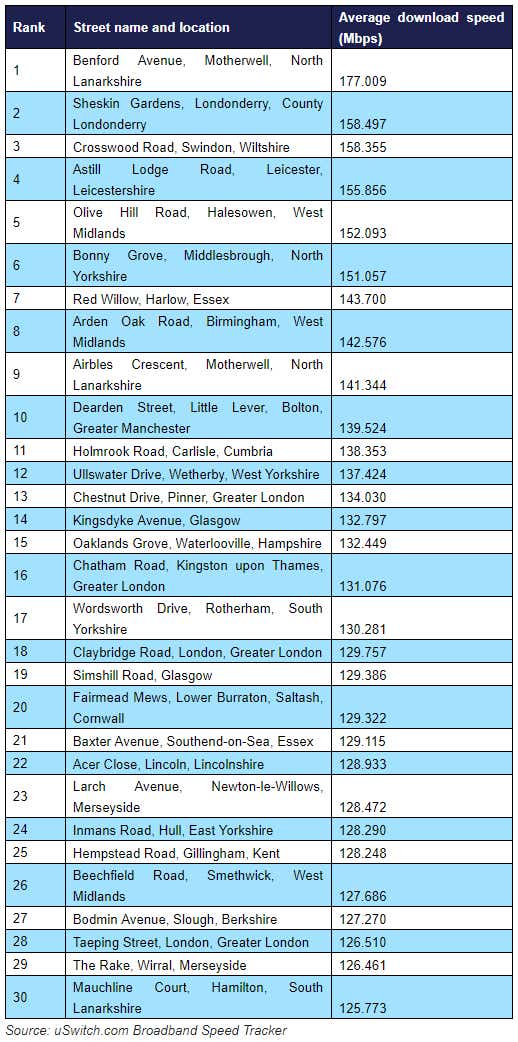The slowest street for broadband is Thorpe Lane, Trimley St Martin in Suffolk, while Benford Avenue, Motherwell in North Lanarkshire is the fastest
Thorpe Lane has a dire average speed of 0.68Mbps – 260 times slower than Benford Avenue’s superfast 177.01Mbps and 53 times slower than the UK average speed (36.2Mbps)
One in five (20.6%) struggle with speeds less than 10Mbps, while nearly one in 10 (8.6%) are especially unlucky, crawling along at less than 5Mbps
Urban areas dominate the field with four of the UK’s fastest streets found in the capital, two in Glasgow and one in Greater Manchester
With superfast services available on more than half of the UK’s slowest streets, Uswitch calls on providers to make property specific broadband speeds available more widely so that consumers can see exactly what services and what speeds are available at their home.
With an average download speed of 0.68Mbps, Thorpe Lane in Trimley St Martin, Suffolk, has the slowest broadband in the UK, according to the latest test data of ‘real world’ speeds collected by Uswitch.com, the price comparison and switching service.
Thorpe Lane’s sluggish average speed is a staggering 260 times slower than the UK’s fastest street, Benford Avenue, Motherwell in North Lanarkshire, where average speeds peaked at 177.01Mbps over the past 12 months – and 53 times slower than the UK average speed for the same period (36.2Mbps).
On Thorpe Lane it would take over 21 hours to download a two-hour HD film on Netflix and nearly eight hours to download a 45-minute HD TV show . By contrast, on Benford Avenue, it would take less than five minutes to download a two-hour HD film and 109 seconds to download a 45-minute HD TV show .
According to the research, which is based on more than one million ‘real world’ speed tests run by broadband users over the last year, one in five (20.6%) broadband users struggle along with speeds of less than 10Mbps – while nearly one in ten (8.6%) crawl along at less than 5Mbps.
However, the number of broadband users enjoying faster speeds is growing. Nearly four in ten (36.7%) now get average speeds of 30+Mbps, which is up from 22% two years ago. But despite the fact that fibre broadband should be available to 95% of UK households by the end of 2017, a recent Uswitch survey found that only 57% of Brits believe they can access it in their local area.
Broadband users living in and around the UK’s largest cities are the most likely to find themselves with superfast speeds. Four of the UK’s fastest broadband streets can be found in the capital, while Glasgow contains two of the UK’s quickest streets and another is located in the Greater Manchester area. Additionally, the Scottish town of Motherwell contains two of the fastest streets in the UK for broadband speeds.
Conversely, two of the five roads identified as languishing at the bottom of the table for broadband speeds can be found in Suffolk, where you could drive the 30 minute trip from Thorpe Lane in Trimley St Martin to Creeting Lane in Creeting St Peter over 17 times in the time it takes to download an episode of Stranger Things at Thorpe Lane.
When it comes to broadband speeds, it’s still very much a postcode lottery. Two of the slowest and two of the fastest streets can be found in Essex. Red Willow in Harlow, for example, is less than a 40 minute drive from Noak Hill Road in Billericay, but boasts broadband speeds that are 143 times faster.
Surprisingly, on more than two thirds of the UK’s 30 slowest streets, fibre broadband is available so customers needn’t be wallowing on these glacial speeds.
The table below shows the 30 slowest streets for broadband in the UK:

The table below shows the 30 fastest streets for broadband in the UK:

Ewan Taylor-Gibson, broadband expert at Uswitch.com, says: “It is astonishing to think that you could fly to Sydney in Australia in the time it takes to download a film on the UK’s slowest street.
“While cable services offering the fastest broadband speeds aren’t available at any of the UK’s slowest streets, fibre-to-the-cabinet broadband should be accessible at more than half of the most sluggish postcodes, something that might be a surprise to those that have been frustrated enough to run a speed test.
“Whilst Ofcom has proposed having providers give more information on what speeds consumers should expect, unless this information is presented transparently, in a way that enables broadband users to compare the available options side-by-side, these changes won’t be truly effective.
“What consumers want to know is what they are getting now and how that compares to services they could access. Only then will consumers be fully empowered to make an informed decision about which service is right for their needs.
“Consumers that are not happy with their service and do not feel it delivers should let their provider know right away. Reasons for such sluggish broadband speeds can vary and can include a user’s distance from the nearest exchange or difficulties with the property itself – thickness of walls, for example, can affect wireless connections. While there are measures that your broadband provider can offer to improve your signal, such as moving your router to reduce interference from other electronics, physically connecting your devices to the router using an Ethernet cable and Wi-Fi boosters, it might be worth seeing if faster services are available in your area.”
Anyone frustrated with their broadband service can test their speeds and compare their results to other local users with different providers here: www.uswitch.com/broadband/speedtest
Find out how you could save over £1,000 a year with Uswitch here.
FOR MORE INFORMATION
Claire Jones
Phone: 020 7148 4663
Email: Claire.Jones@uswitch.com
Twitter: @uswitchPR
Notes to editors
Broadband users ran a grand total of 1,064,681 consumer speed tests during the twelve-month period 1st September 2016-1st August 2017 inclusive, using Uswitch.com’s free speed testing tool.
For the top 30 streets
We took the slowest and fastest postcodes from the 1,064,681 speeds tests, across 76402 unique IP addresses within 9099 postcodes. These were taken over a twelve month period - 1st September 2016 to 1st August 2017. In order for a street to qualify for inclusion in the top or bottom 30, tests from at least three unique IP addresses and at least 10 residential properties were required at a postcode.
1. See tables of UK’s 30 slowest and 30 fastest streets for broadband above
2. Fastest street in the UK is Benford Avenue (177.009Mbps) and the slowest street is Thorpe Lane (0.679 Mbps). Average download speed is now 36.2Mbps according to the latest Ofcom research. Calculations: 177.009/0.679 = 260.7 and 36.2/0.679 = 53.3
3. Figures take all 30,051,858 consumer speed tests into consideration
4. Calculated using this online tool: http://www.download-time.com/ File sizes: average 2-hour HD film on Netflix is 6Gb, average HD 45-minutes TV show on Netflix is 2.25Gb.
5. Based on 1,030,865 consumer speed tests during the six-month period Aug 2014-Feb 2015
6. Broadband Delivery UK intends to provide superfast broadband coverage to 95% of UK premises by the end of 2017
7. From Uswitch research conducted via Opinium from 28-31 July 2017. Sample: 2,004 nationally representative UK adults (aged 18+)
8. Average episode length of ‘Stranger Things’ is 50 minutes, or 2.5Gb in size for Netflix HD. Download time at Thorpe Lane (0.679Mbps) is eight hours and 47 minutes. Driving from Thorpe Lane to Creeting Lane is 30 mins.
Calculation: 526/30 = 17.5
9. Red Willow = 143.7. Noak Hill Road = 1.007. 143.7/1.007 = 142.7
10. Flight time from London to Sydney, Australia is 20 hours, 42 mins; time to download an HD movie with a speed of 0.679Mbps is 21 hours, 5 minutes and 5 seconds
About us
It’s all about “U”!
Thank you for indulging us over the last 20 years by using a small ‘u’ and a big ‘S’ when writing about our brand in your articles.
We are delighted to let you know that you are now off the hook - it’s big U’s all the way (and small s’s) as we undertake our biggest ever rebrand - so let your autocorrect go wild!
About Uswitch
Uswitch is the UK’s top comparison website for home services switching. Launched in September 2000, we help consumers save money on their gas, electricity, broadband, mobile, TV, and financial services products and get more of what matters to them. Last year we saved consumers over £373 million on their energy bills alone.
Uswitch is part of RVU, a new business that also owns Money.co.uk and Bankrate.
If you would no longer like to receive our press releases please email prteam@uswitch.com with 'unsubscribe'.
